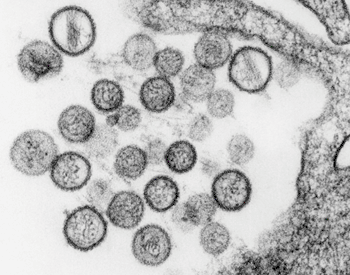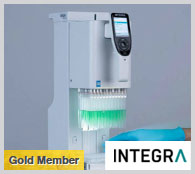Immunofluorescence Assay Developed for Hantaviruses
By LabMedica International staff writers
Posted on 16 Apr 2013
Simultaneous tests were developed for clinically important Old and New World hantaviruses using multiparametric indirect immunofluorescence assays (IFAs) based on biochip mosaics. Posted on 16 Apr 2013
To detect serum antibodies each of the mosaic substrates consisted of cells infected with one of the virus types Hantaan (HTNV), Puumala (PUUV), Seoul (SEOV), Saaremaa (SAAV), Dobrava (DOBV), Sin Nombre (SNV) or Andes (ANDV).

Image: transmission electron micrograph (TEM) of the Sin Nombre virus (Photo courtesy of Cynthia Goldsmith).
Scientists from the Euroimmun Medizinische Labordiagnostika AG, ( Luebeck, Germany) in collaboration with others, analyzed 184 laboratory-confirmed Hantavirus-positive sera collected at six diagnostic centers from patients actively or previously infected with different Hantavirus serotypes. The control panel comprised 89 sera from healthy blood donors. The Euroimmun’s Hantavirus Mosaic 1 and 3 were used for the multiparametric IFA-based detection of Hantavirus-specific immunoglobulin G (IgG) and IgM.
The overall qualitative performance of multiparametric IFAs in detecting anti-Hantavirus antibodies was analyzed by considering those samples as seropositive that showed specific reactivity with a cut-off 1:100, against at least one of the different Hantavirus serotypes contained in the biochip mosaics. In the multiparametric IFA applied in the study, 99% of the patient sera were IgG positive and 71% were IgM positive. Overall IFA sensitivity for combined IgG and IgM analysis amounted to 100% for all serotypes, except for SNV, which was 96%. Of the 89 control sera, 2% showed IgG reactivity against the HTNV substrate, but not against any other Hantavirus.
The authors concluded that analysis of Hantavirus-specific IgG and IgM by indirect immunofluorescence on substrate mosaics consisting of cells infected with different hantaviruses is a globally applicable. The method is a reliable diagnostic tool for screening of patients suspected of having Hantavirus infection, and can be useful for serotyping in areas where hantaviruses of different serogroups are endemic. The multiparametric IFA enables highly sensitive and specific serological diagnosis of Hantavirus infections and can be used to differentiate PUUV and ANDV infection from infections with Murinae-borne hantaviruses such as DOBV and SEOV. The study was published on April 4, 2013, in the journal Public Library of Science Neglected Tropical Diseases.
Related Links:
Euroimmun Medizinische Labordiagnostika AG













